You may not find this terribly rewarding unless you're included here, so this is a good time for casual and random browsers to turn back before they get too caught up in the sweep and majesty of the proceedings and can't let go.

Melvin the Doge greets the day in Montegiardino, Italy, 17 December 2017

We're en route for the walled town and castle of Gradara, with a speeding look back at San Marino and its three towers.

Cute little roads through the hills

Tiresome cute little roads through the hills

And a detour for the Sunday street market in Montescudo, but in the fullness of time (45 minutes) . . .

. . . we arrive in the carpark above the modern suburbs of this tiny town of ca. 3,500, just below the well preserved fortifications of the medieval town.
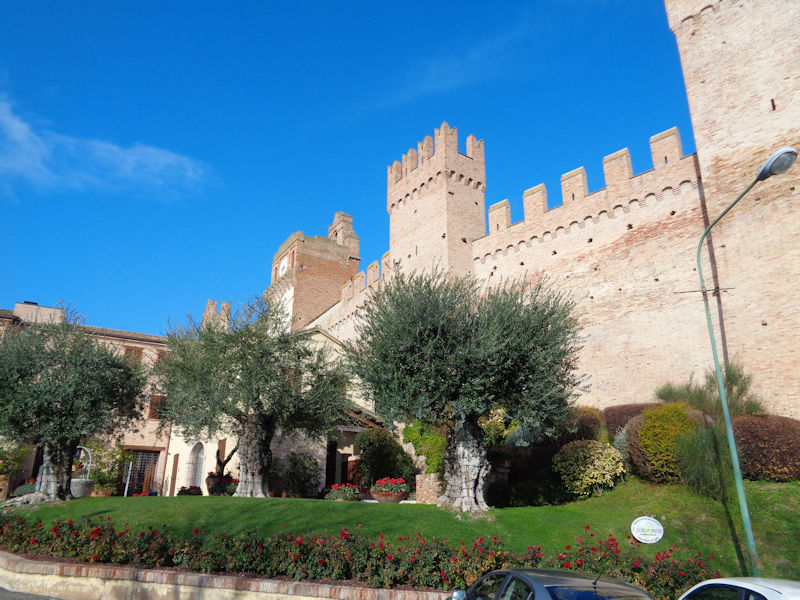
Gradara, in the province of Rimini-Pesaro in the Italian region of Marche, sits on a defensible hilltop at 140m above sea level, 23km south of Rimini, 13km north of Pesaro, and just 25km (as the crow flies, which is very misleading) from the three clifftop towers of the foreign nation of San Marino. And less than 3km above the Adriatic Sea.

This shows the fortified medieval borgo, leading up the main street to the curtain wall of the rocca or fortress, and within that, the castle itself with its keep or donjon and its residential facilities. Despite the great age of the establishment, it was continuously inhabited by noble families mostly from Pesaro but latterly from others farther afield. A fellow named Umberto Zanvettori of Belluno bought the castle in 1920 and did a masterful job of preparing the place for our visit.

Apart from any Neolithics or tribal Umbri who may have got a headstart on the hilltop, medieval Gradara began life in the 1100s as a fortified tower built by the de Grifo family of Pesaro, but it was taken over by the Malatestas in the mid-13th century. Malatesta I da Verruchio had been hired as the Ghibelline podestà of Rimini in 1239, but after the death of the Emperor Frederick II in 1250, he became head of the Guelph or pro-papal alliance in Romagna and the Marche, and at some point before this he had acquired Gardara amongst many other properties (in 1295 he declared himself Lord of Rimini, a title which, with its ups and downs, remained in force until 1527). Malatesta's son Gianciotto ('Giovanni the Lame') established the Pesaro line of the family, including Gradara, in 1294.

We progress up through the city gatehouse, with the remains of its drawbridge over the gate.
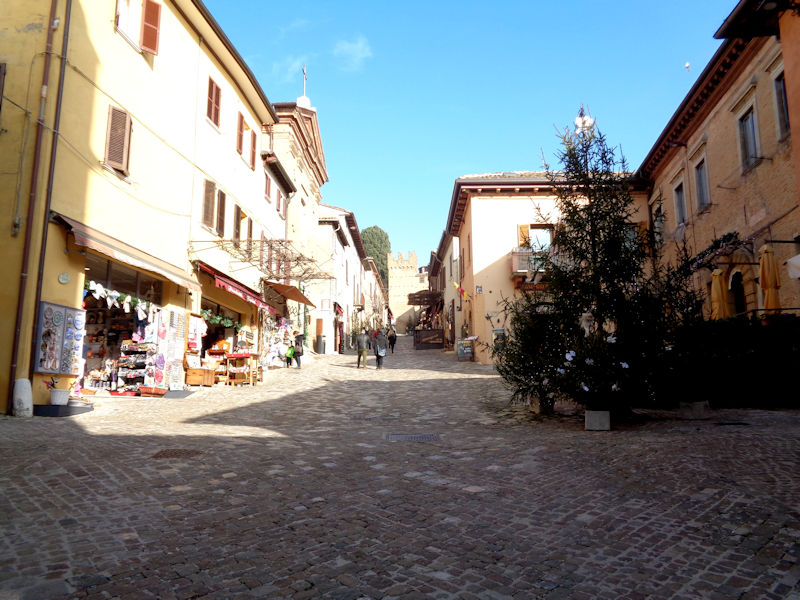
Once inside the gate, we glance up the main street, the Via Umberto I, and immediately head up the gatehouse for the ramparts.

Tourists!!
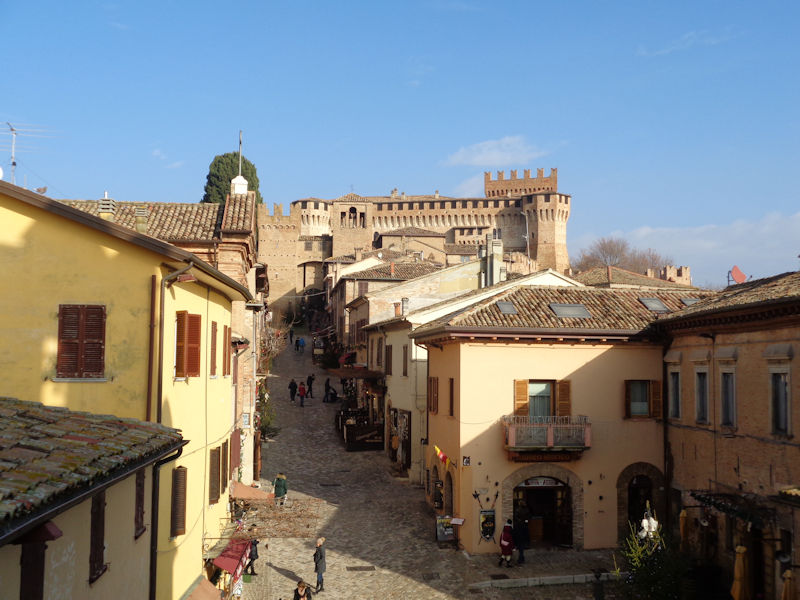
Up on the gatehouse, with a fine view of the rocca or Castello di Gradara, and surprisingly, a blue sky.
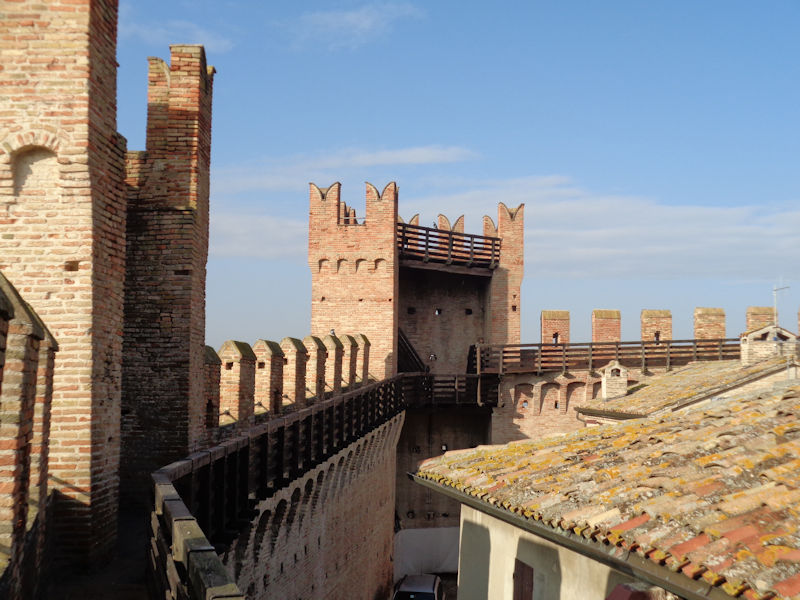
It's a fine 300m walk round the ramparts on the western side (the city walls are 800m all round).
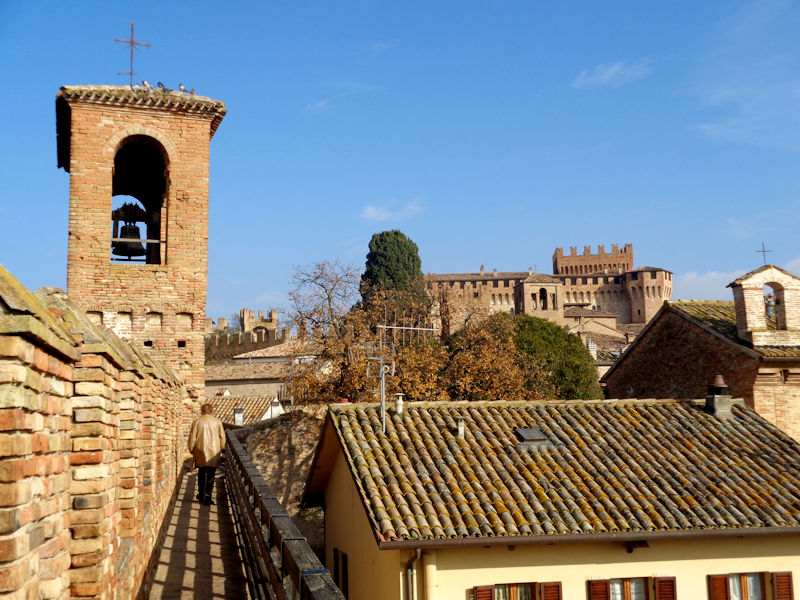
The town and castle saw a fair amount of action in their time, particularly during the Lombardy Wars of the first half of the 15th century, and especially in the interminable feuds between the Malatesta family and the Montefeltros, who were usually associated with Urbino and Gubbio but who came originally from the castle at San Leo, originally Monte Feltro (from its Roman name Mons Feretus), just 35km up into the hills.
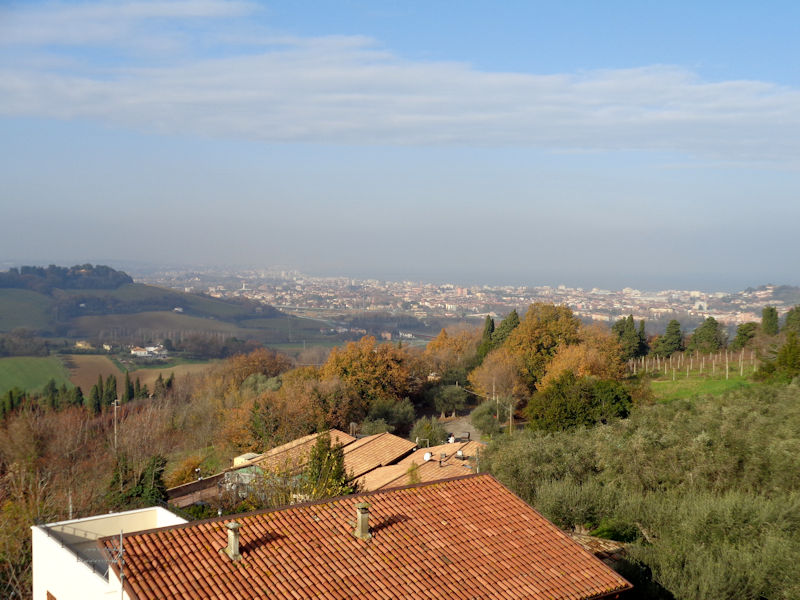
The view from the battlements down at the city of Cattolica 3km down the hill on the coast.
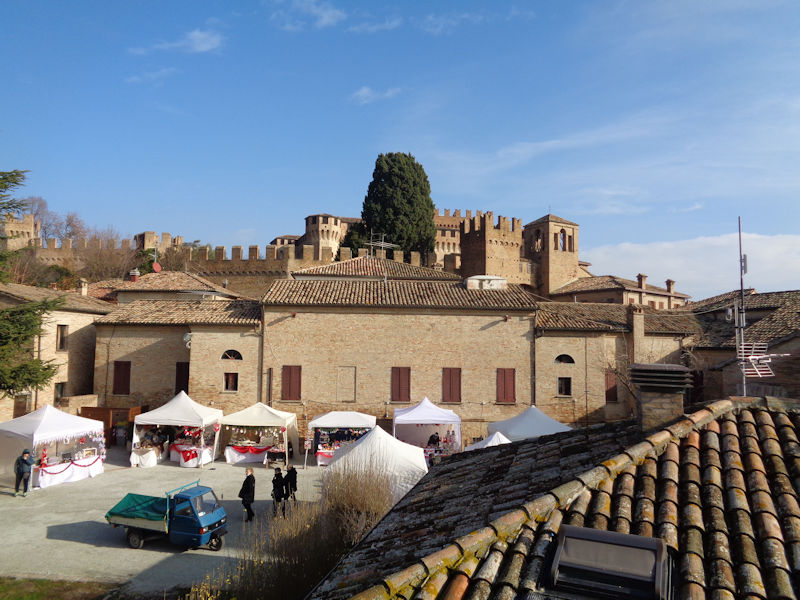
The fortress and what looks like part of a Christmas market below us
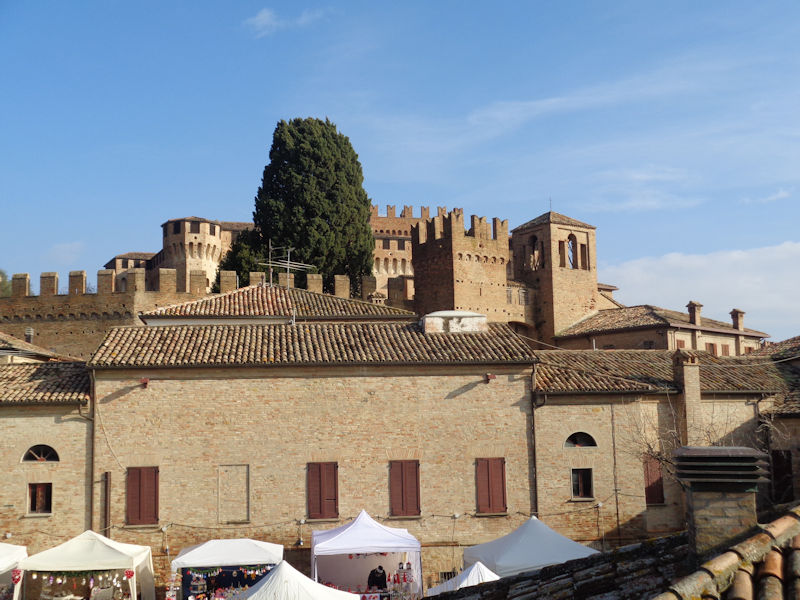

Perhaps as we get closer to Christmas, trade will pick up.
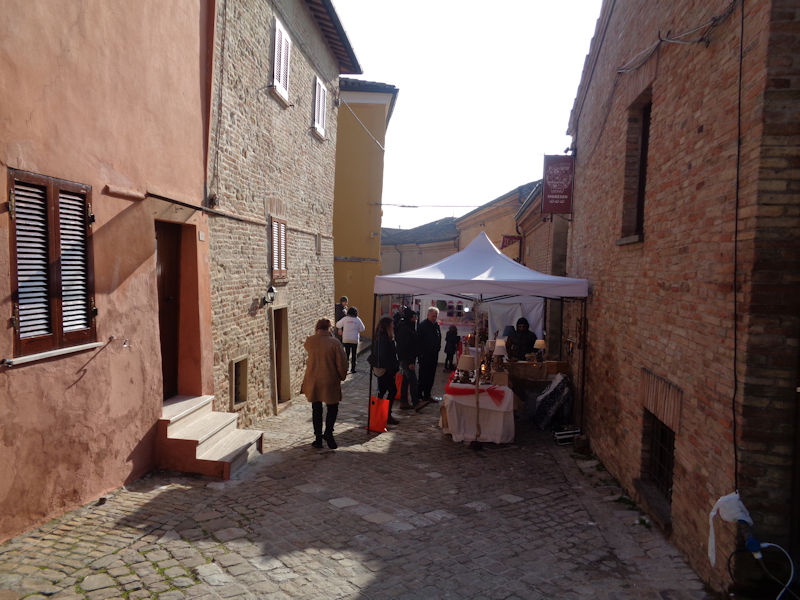
We're off the ramparts and heading for the fortress gate

The main and one of only two gates of the Rocca, with the Chiesa di San Giovanni Battista, from 1290, just inside on the right.
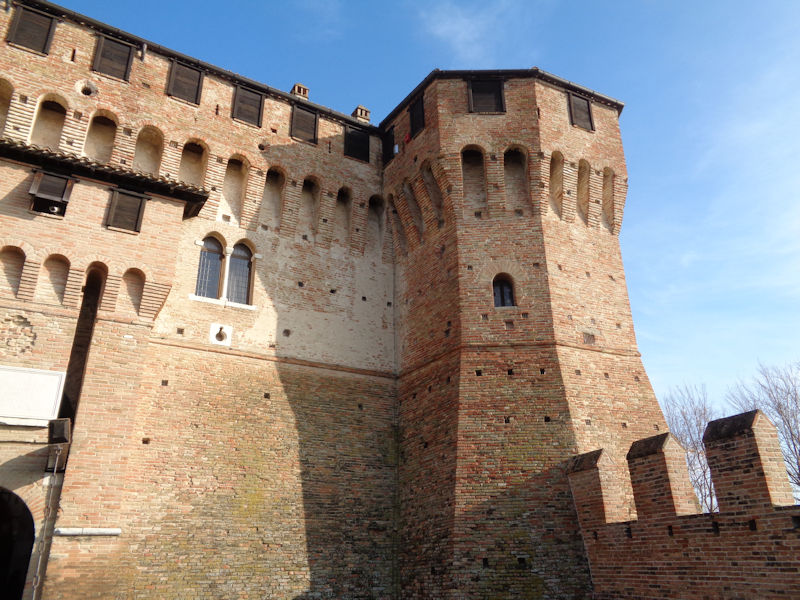
One of the octagonal corner towers, overlooking the gate into the castle

The secondary entrance into the fortress, seen from the gate into the castle keep

It seems to have been Sigismondo Pandolfo Malatesta, Lord of Rimini, who put the fortress into its present form in the mid-15th century, though the noble families who have occupied the place in the centuries since then have made their own alterations and arrangements within. In 1445 Galeazzo ('the Inept') Malatesta, financially ruined from his wars against his cousin Sigismondo, sold Gradara to Francesco Sforza, but when Francesco came to collect it, Sigismondo was here to see him off after a 40-day siege.
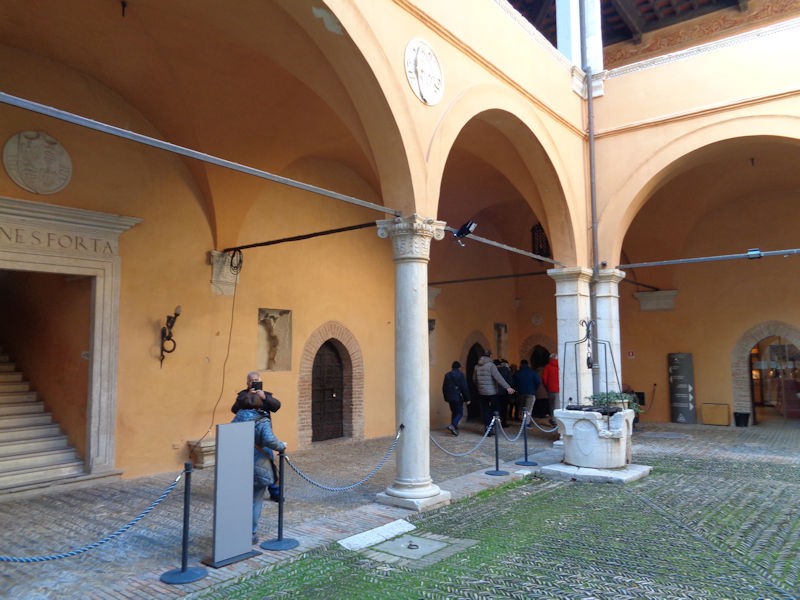
The castle courtyard and its well. In 1463, however, Sigismondo had been excommunicated in his feuds with the papacy, and Federico da Montefeltro of Urbino was hired by the church to come along and take Gradara away from him, which he did with a successful siege. Pope Pius II then handed Gradara over to the papal friends the Sforzas of Pesaro to administer as imperial vicars.

'Sigismondo and Isotta's room', romantically named in the 18th century for Sigismondo Pandolfo Malatesta and his long-time mistress and later wife Isotta degli Atti.

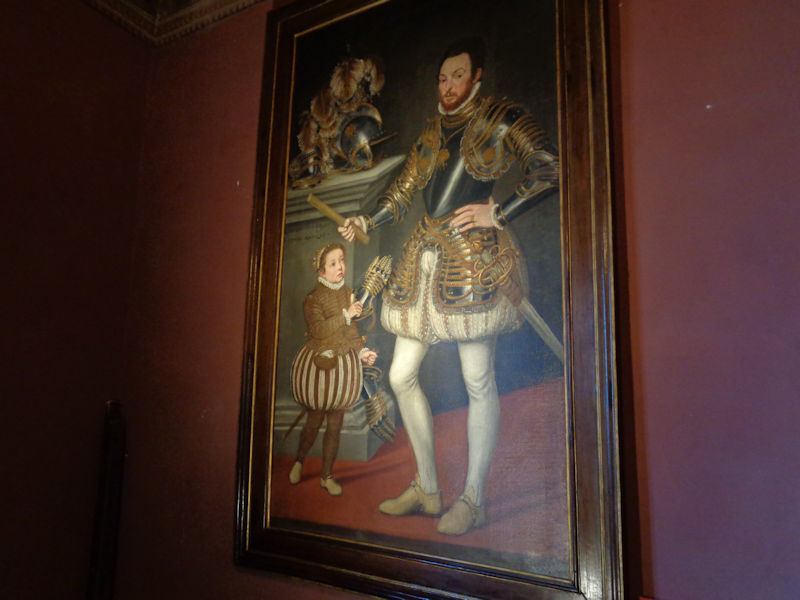
A portrait of Giacomo Malatesta (1530-1600), a professional condottiere or military commander who fought for everybody everywhere, with his daughter Leonida, signed 1562.
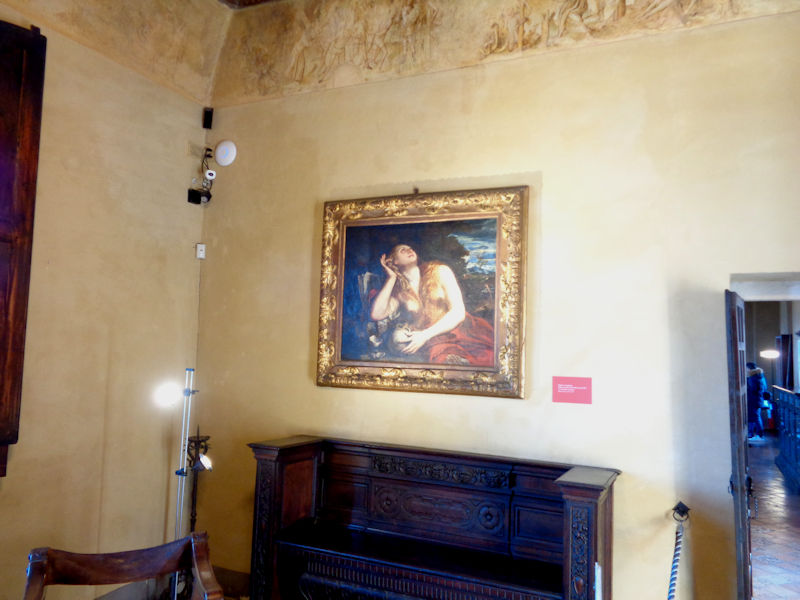
A classic 'Magdalene as Penitent', by an unknown 16th century painter. By the time of Giacomo Malatesta, Gradara was no longer a Malatesta property, but more recent owners have gone out of their way to acquire furnishings, pictures, and other reminders of the Malatesta heritage here. Alessandro Sforza, an illegitimate son of the founder of the Sforza dynasty Muzio Attendolo Sforza and brother of Francesco, the future Duke of Milan, was a condottiere commander who founded the Sforza line of Lords of Pesaro, and in 1464 he was granted the seigniory of Gradara in 1464 by Pope Pius II (the author Aeneas Sylvius Piccolomini) and defended it against several Malatesta attempts to get it back.
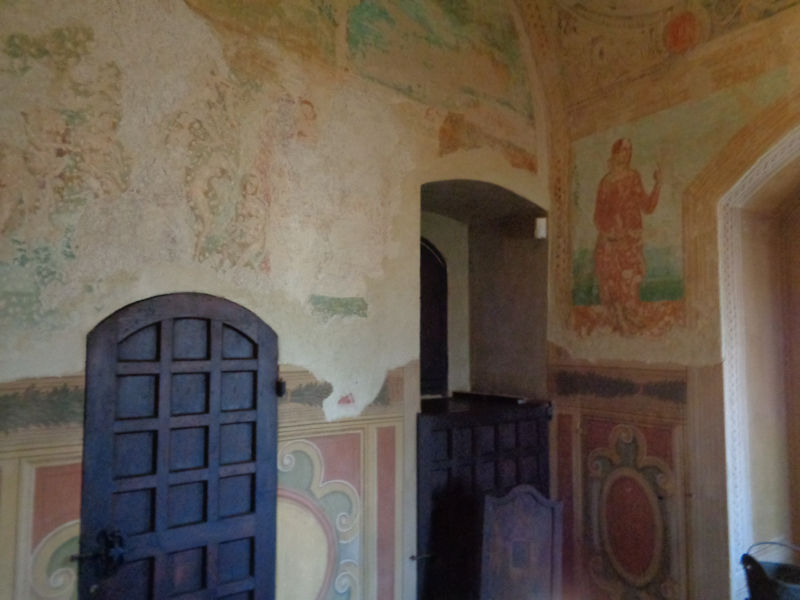
This is called "Lucrezia Borgia's dressing room". Alessandro's son, Costanzo I, another professional soldier, inherited the lordship of Pesaro and received Gradara as a papal fief from Pope Alexander VI Borgia, and in 1483 his illegitimate son Giovanni Sforza, also a condottiere, succeeded him in the combined papal lordship of Pesaro and Gradara.

It might not really be Lucrezia's room, but it could easily be so; the allegorical figures on the walls and ceiling are said to suggest romantic and marriage themes, and in June 1493 Lucrezia's father, Pope Alexander VI, married her off (at the age of 13) to Giovanni Sforza for political advantage; they certainly resided in Pesaro at least briefly and very likely here, too, as well as at the papal court in Rome, but before long, the Pope found a better match for her, and Giovanni was forced to consent to an annulment based on his false confession of impotency, finalized in December 1497. In 1498, Lucrezia was married to Alfonso of Aragon, but he was murdered in 1500, and she was finally able to settle down in Ferrara by marrying Alfonso d'Este, soon to succeed as the Duke of Ferrara, in January 1502.
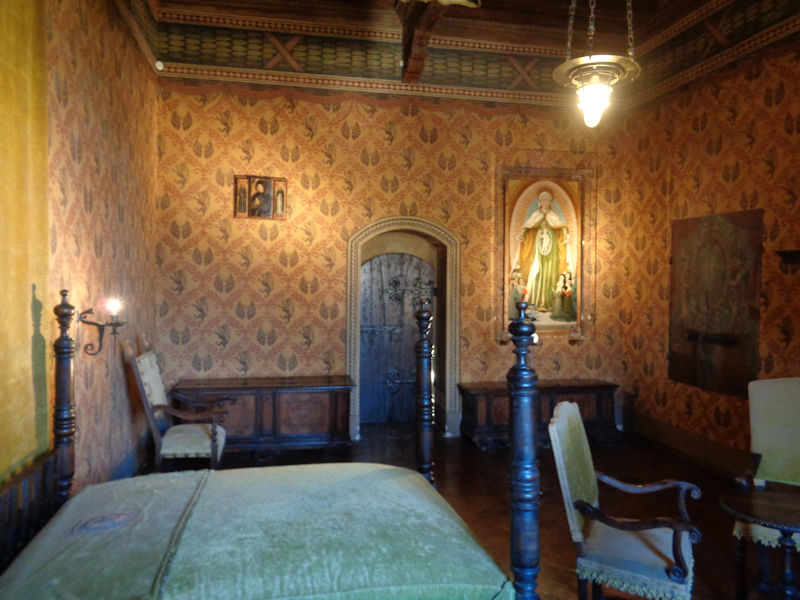
This is known as the Sforza Lion Room, with walls decorated in the 1920s with rampant lions and winged dragons, symbols of the Pesaro branch of the Sforza family, who ended their rule here in 1512 with the childless death of 2-year-old Giovanni Maria, called Costanzo II Sforza, the only heir of Giovanni Sforza, Lucrezia's ex.
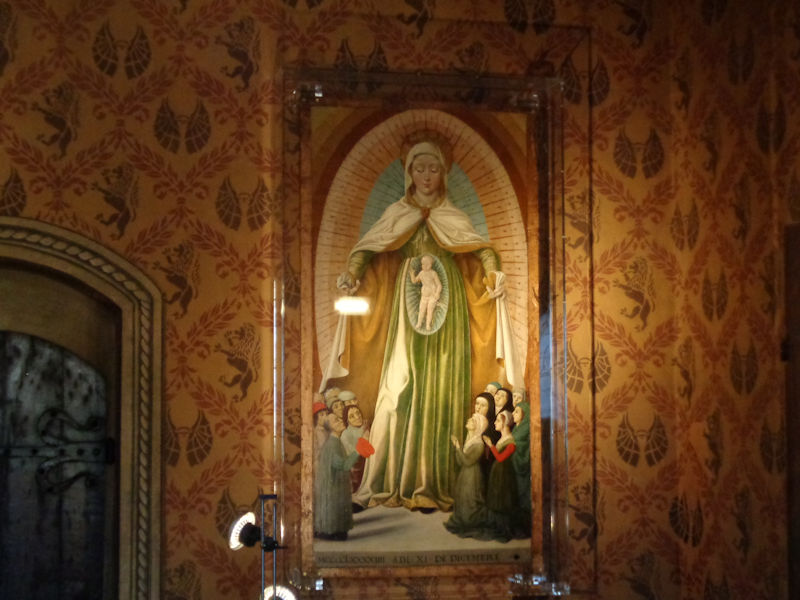
Similar symbols on the original wood ceiling were commissioned by Giovanni Sforza himself. The Madonna Misericordia picture is by an unknown local artist, and is dated 1494 at the bottom.

The Cardinal's Room, with 17th and 18th century furniture, and a Madonna della Misericordia by Giovanni Giacomo Pandolfi of Pesaro, dated 1611.
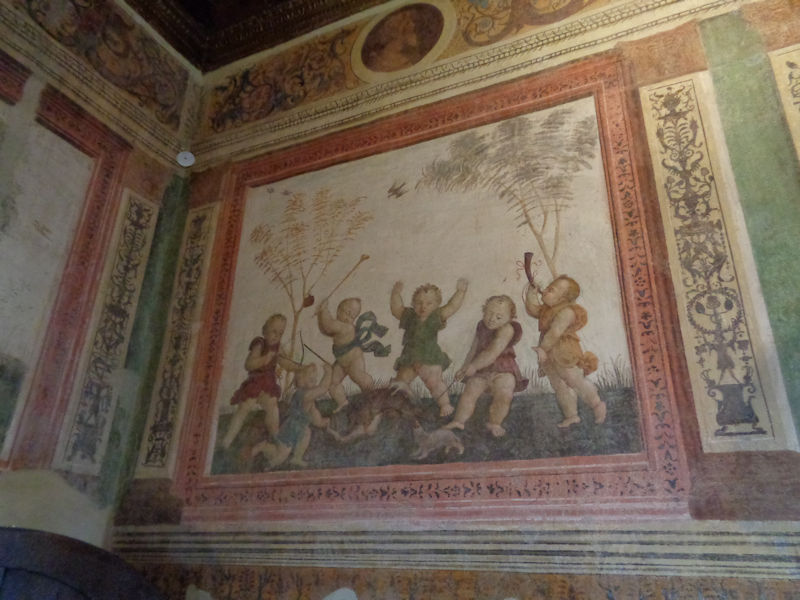
The Putti Room, with "Children's Games" frescoes all round done in the period 1503-1510, by Girolamo Marchesi da Cotignola (the Sforzas' hometown), who spent time working in Forlì and Pesaro at the time. According to the labeling here, they may have been done on the occasion of the birth of Costanzo in 1510, here in Gradara, to Giovanni Sforza and Ginevra Tiepolo -- more likely, however, we're told, they're associated with a celebration of the return of Giovanni to his territories here after the collapse of Cesare Borgia's programme for creating his own dukedom in this region, following the death in 1503 of his father the Pope. (And after 1512, the Della Rovere family, supported by their own Pope, Julius II, took over, following which Gradara was absorbed into direct control by papal agents until Napoleon came.)

The Red Room, with more heraldic symbolism of the Sforza family

The Council Hall, a hypothetical name . . .

. . . based on the presence of 18th century choir benches along the walls.
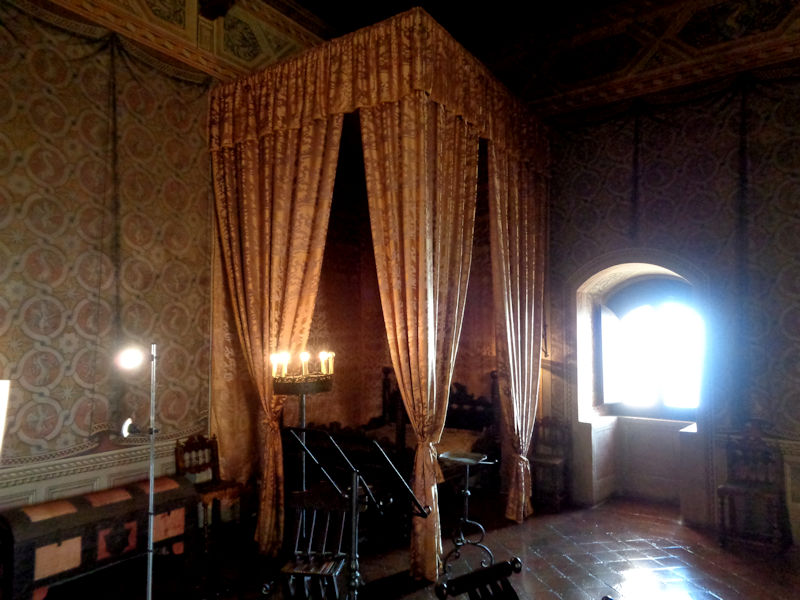
This room is somewhat fancifully called Francesca's Room after the popular medieval legend of the passionate love affair between Paolo and Francesca, immortalized sympathetically by Dante, who meets them in Circle II of the Inferno (Canto V), where they are whirled forever in a black whirlwind symbolizing the triumph of lustful passions over reason. Francesca da Rimini (the aunt of one of Dante's best friends) was married to the eldest son of Malatesta I da Verucchio, Lord of Rimini: Gionciotto ('Giovanni the Lame') Malatesta, who made himself permanent podestà of Pesaro in 1294. His handsome brother Paolo fell for Francesca, and whilst reading the 'erotic' Arthurian story of Queen Guinevere and Sir Lancelot together they were overcome with self-indulgence, for a considerable time apparently. Gionciotto discovered them and killed them both.
'Legend says', plausibly enough, that the fatal deed occurred here in Gradara. We're told that the owner Zanvettori, in the 1920s, had this room done up with inspiration from the theatrical version of the story by Gabriele D'Annunzio, starring Eleonora Duse.
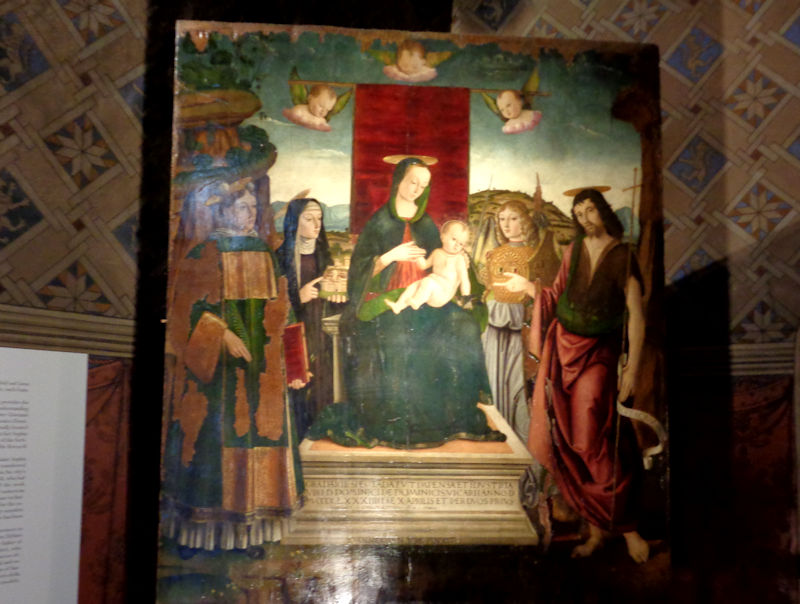
This is a Madonna and Child with Saints Stephen and Sophia, the Archangel Michael, and John the Baptist, commissioned by the vicar of the parish church of St Sophia outside the town walls. Sophia is holding a model of the Rocca di Gradara. This picture is dated 1484 and signed by Giovanni Santi, the father of the great Raphael.
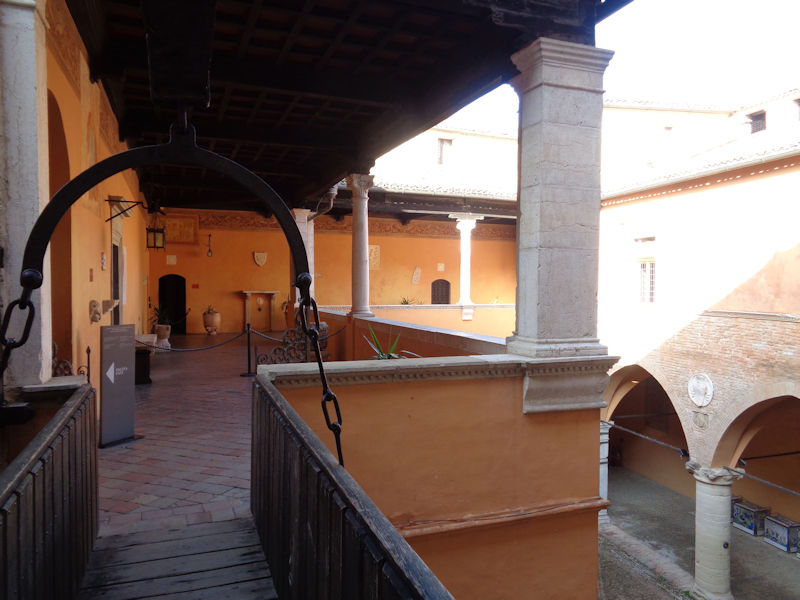
Leaving the keep or donjon, which was originally separate from the residential block.

The same bridge from the other direction
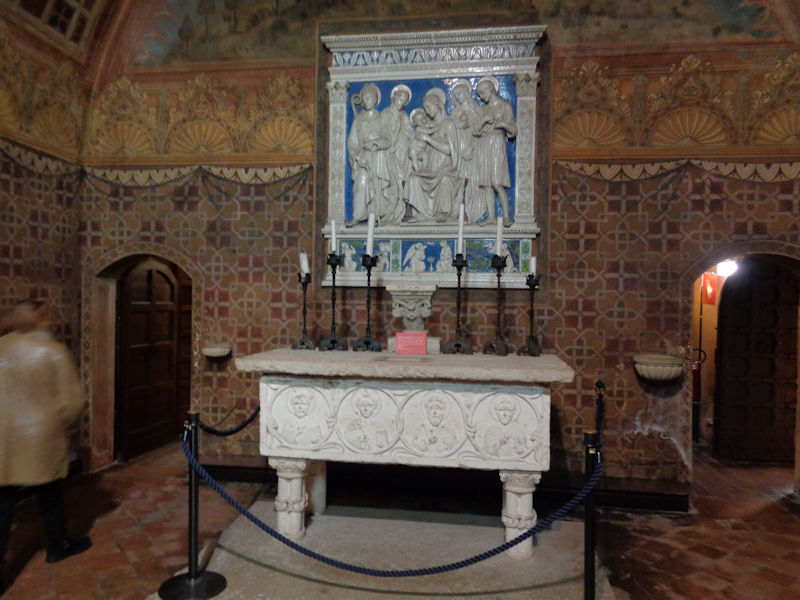
This is described as a room of unknown original purpose which was rebuilt as a chapel in the 18th century . . .
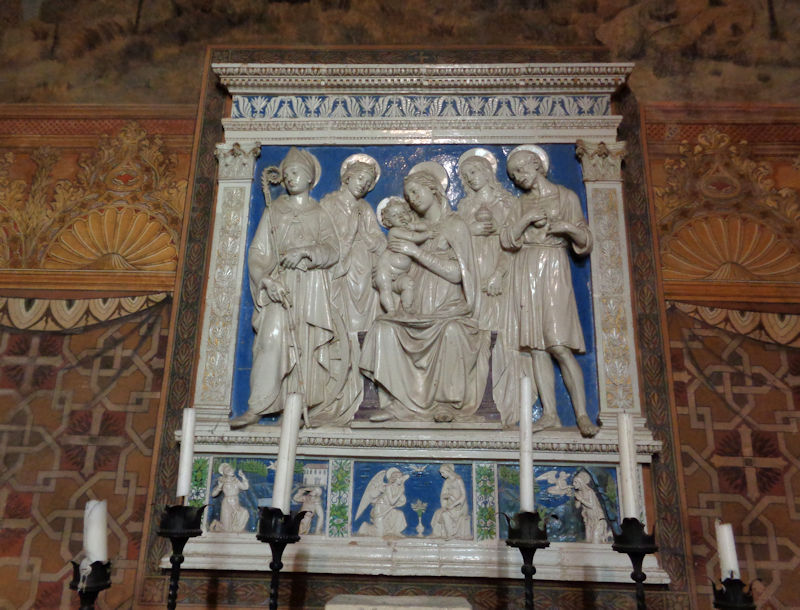
. . . with an original glazed terracotta altarpiece by Andrea della Robbia, late 15th/early 16th century.
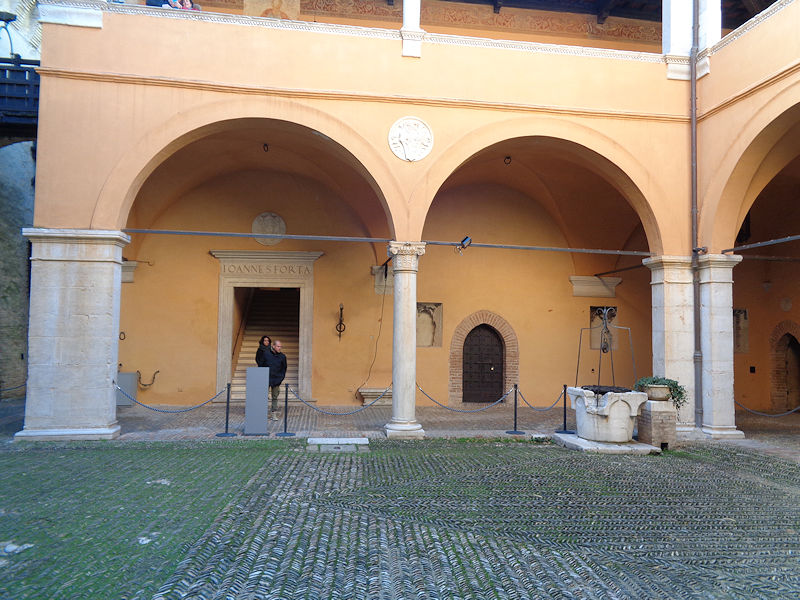
The way out through the courtyard. The name over the door looks like Latin for Giovanni Sforza.
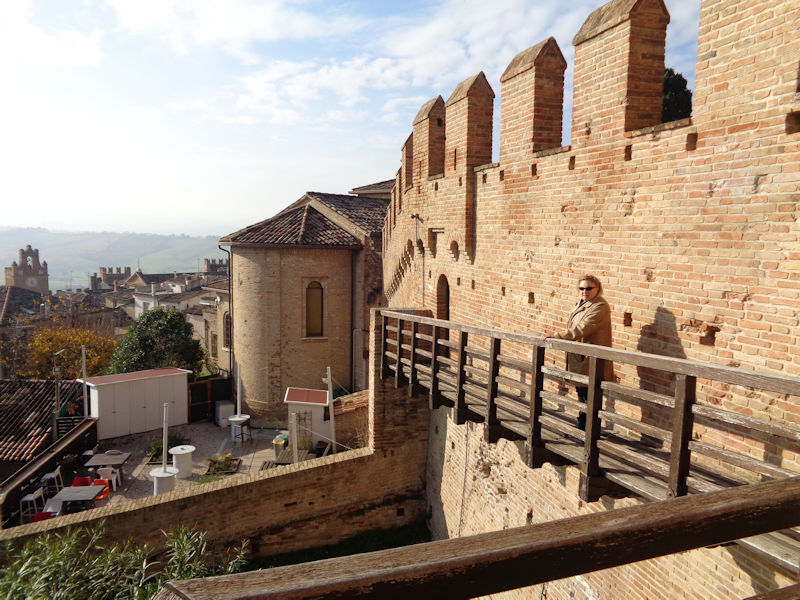
Kristin, briefly outside the castle wall
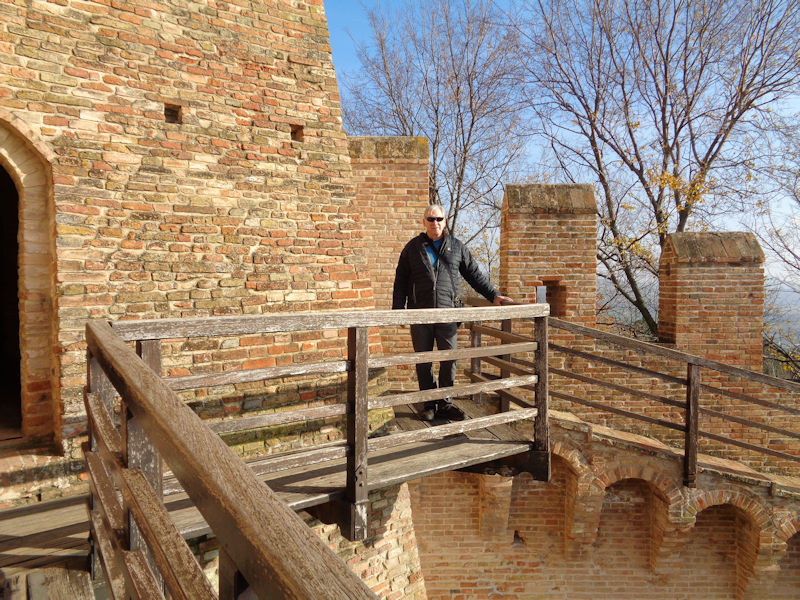
A passerby, outside the castle wall
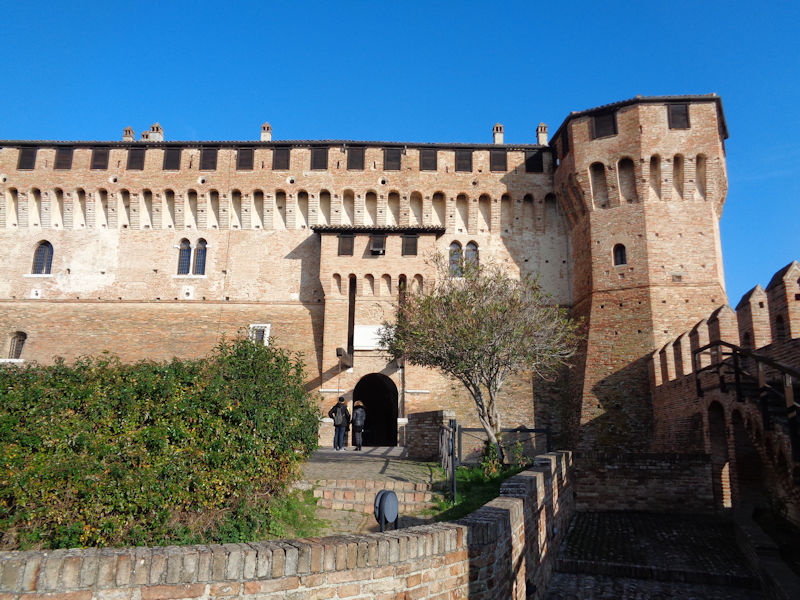
And back inside the castle wall in what might be called 'the exit chute', right back out the front gates, do not pass go.
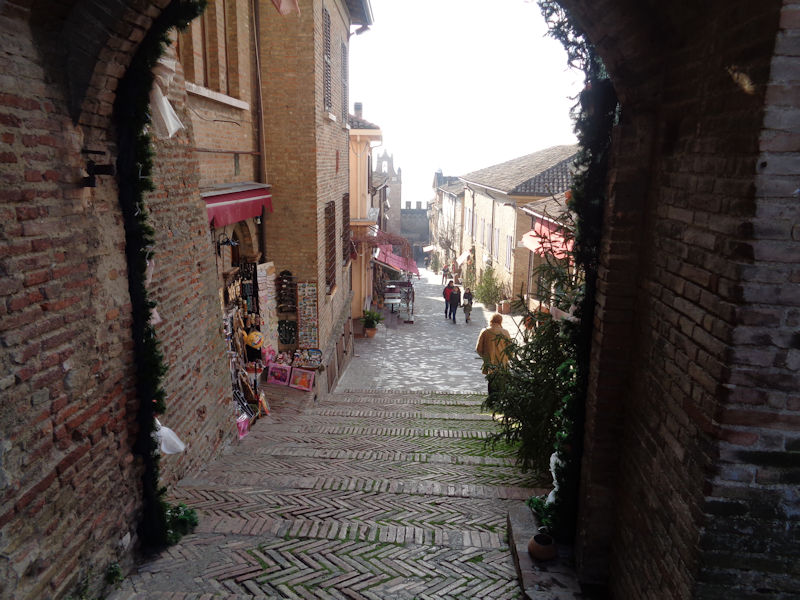
Through the castle gate

Street scene -- the Ristorante Quinto Canto (Paulo and Francesca, Dante, get it?)

The main thoroughfare, Via Umberto I
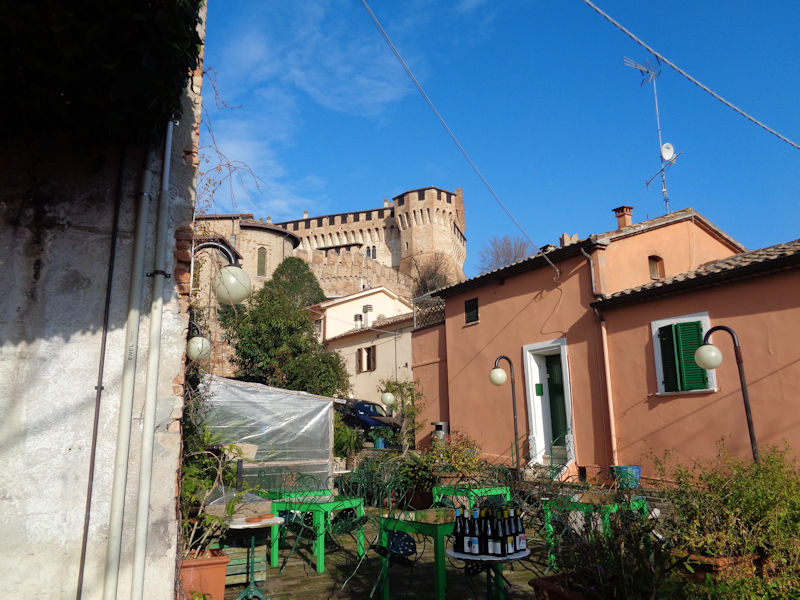
The Rocca from a side street, the Via Roma!
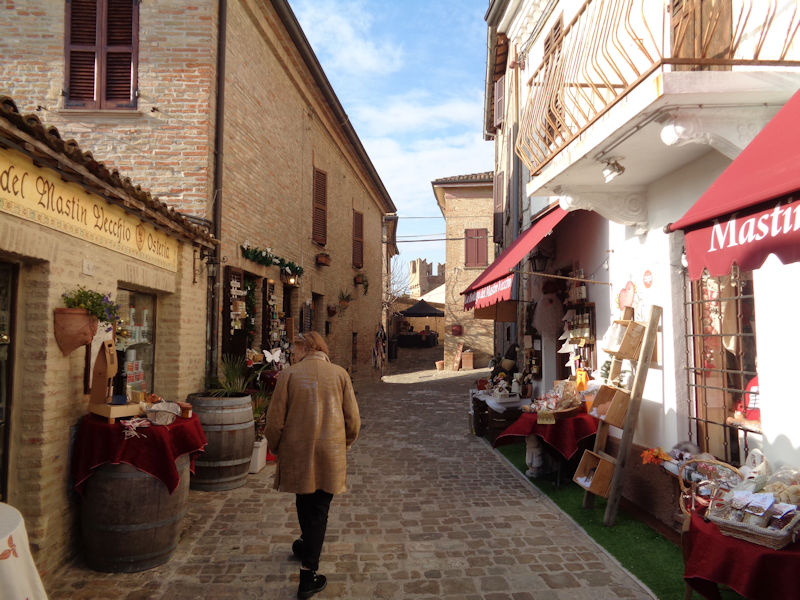
The Via Roma
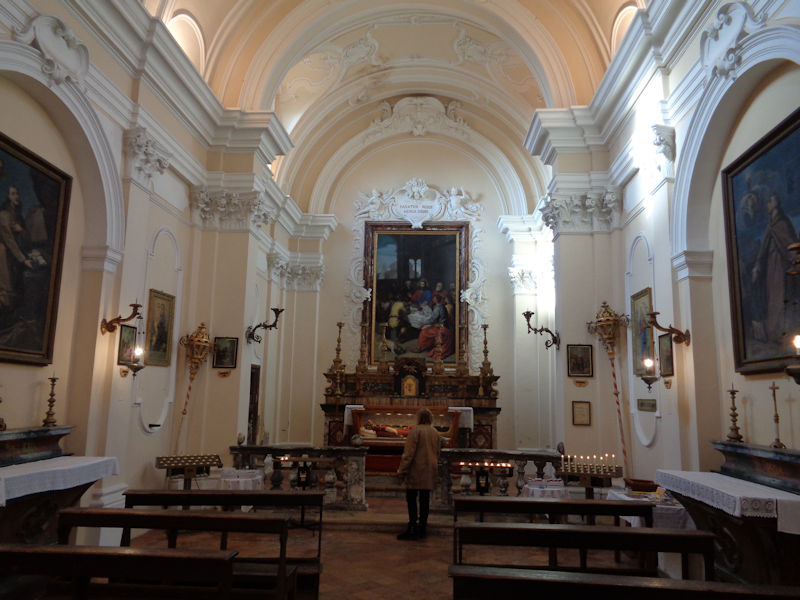
In the Chiesa San Giovanni Battista in Gradara, which we're told (despite appearances) seems to date from before the 1290s.
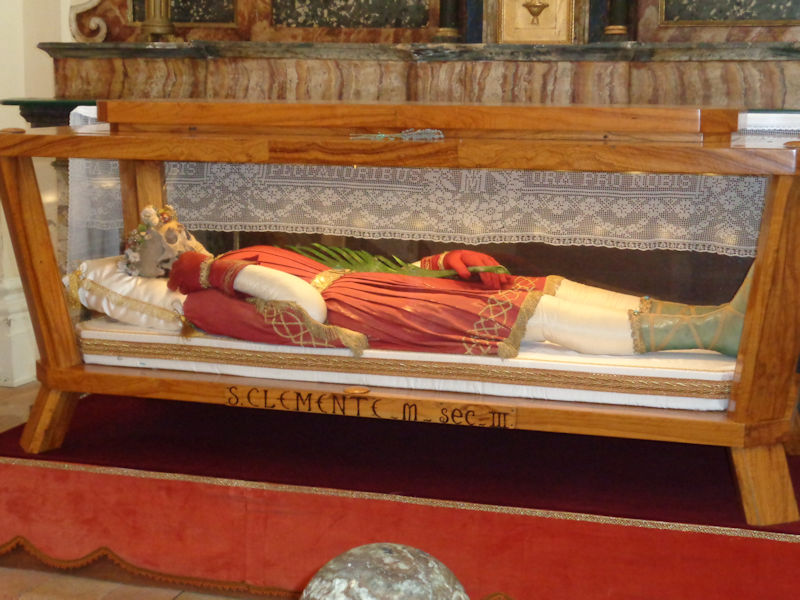
That, according to the label, is, or was, St Clement, 3rd century, well past his sell-by. There were plenty of St Clements, but the only 3rd century Clement was last heard from in Antioch. Other San Clements in the neighborhood, like the Malatesta village in the hills between San Marino and here, take their inspiration from the 1st century Clement of Rome.

Street scene
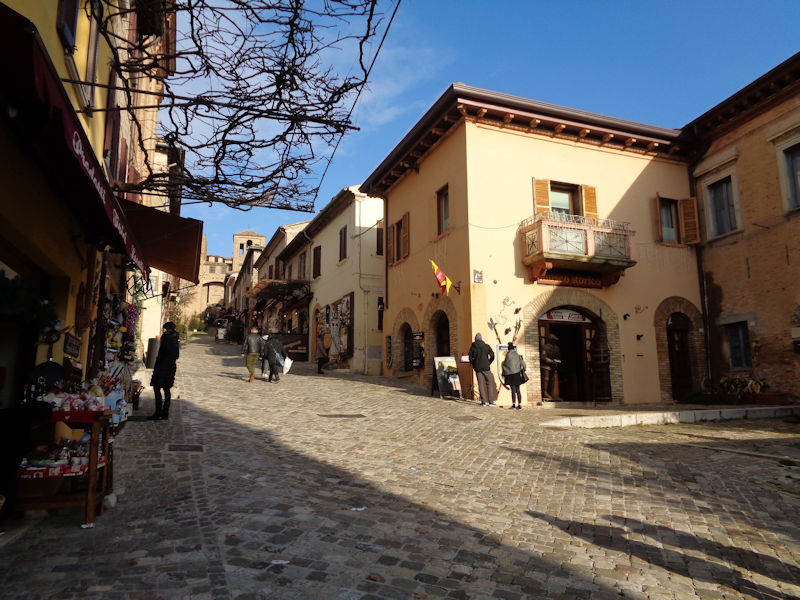
Street scene
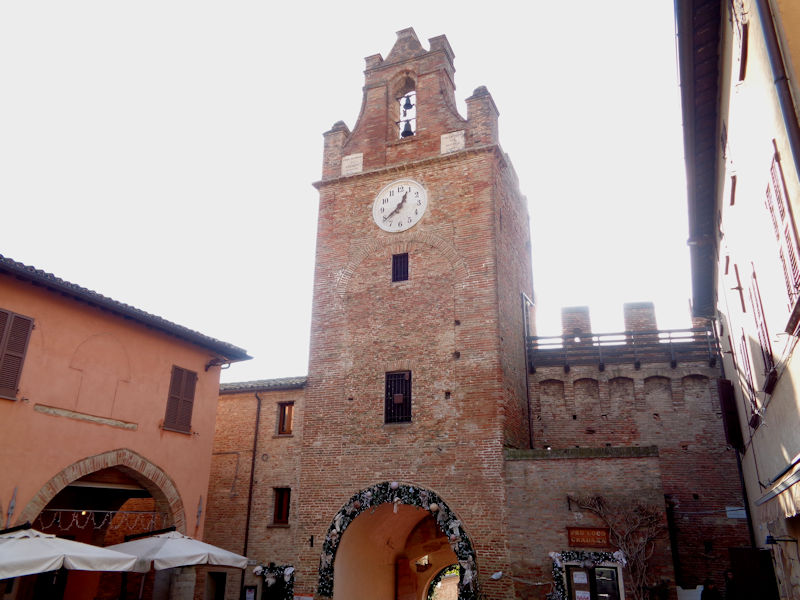
And now out the main gate of the borgo of Gradara

And away.
Next: A hasty walk round Pesaro, and then Fano
